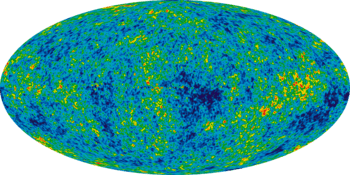Inflationary epoch
| Part of a series on | |||
| Physical cosmology | |||
|---|---|---|---|
 | |||
|
Early universe
|
|||
|
Components · Structure |
|||
| |||
In physical cosmology the inflationary epoch was the period in the evolution of the early universe when, according to inflation theory, the universe underwent an extremely rapid exponential expansion. This rapid expansion increased the linear dimensions of the early universe by a factor of at least 1026 (and possibly a much larger factor), and so increased its volume by a factor of at least 1078.
The expansion is thought to have been triggered by the phase transition that marked the end of the preceding grand unification epoch at approximately 10−36 seconds after the Big Bang. One of the theoretical products of this phase transition was a scalar field called the inflaton field. As this field settled into its lowest energy state throughout the universe, it generated a repulsive force that led to a rapid expansion of space. This expansion explains various properties of the current universe that are difficult to account for without such an inflationary epoch.
It is not known exactly when the inflationary epoch ended, but it is thought to have been between 10−33 and 10−32 seconds after the Big Bang. The rapid expansion of space meant that elementary particles remaining from the grand unification epoch were now distributed very thinly across the universe. However, the huge potential energy of the inflation field was released at the end of the inflationary epoch, repopulating the universe with a dense, hot mixture of quarks, anti-quarks and gluons as it entered the electroweak epoch.
On 17 March 2014, astrophysicists of the BICEP2 collaboration announced the detection of inflationary gravitational waves in the B-mode power spectrum, providing the first clear experimental evidence for cosmological inflation and the Big Bang.[1][2][3][4][5] However, on 19 June 2014, lowered confidence in confirming the cosmic inflation findings was reported.[6][7][8]
See also
Notes
- ↑ Staff (17 March 2014). "BICEP2 2014 Results Release". National Science Foundation. Retrieved 18 March 2014.
- ↑ Clavin, Whitney (17 March 2014). "NASA Technology Views Birth of the universe". NASA. Retrieved 17 March 2014.
- ↑ Overbye, Dennis (17 March 2014). "Detection of Waves in Space Buttresses Landmark Theory of Big Bang". The New York Times. Retrieved 17 March 2014.
- ↑ Ade, P. A. R.; Aikin, R. W.; Barkats, D.; Benton, S. J.; Bischoff, C. A.; Bock, J. J.; Brevik, J. A.; Buder, I.; Bullock, E.; Dowell, C. D.; Duband, L.; Filippini, J. P.; Fliescher, S.; Golwala, S. R.; Halpern, M.; Hasselfield, M.; Hildebrandt, S. R.; Hilton, G. C.; Hristov, V. V.; Irwin, K. D.; Karkare, K. S.; Kaufman, J. P.; Keating, B. G.; Kernasovskiy, S. A.; Kovac, J. M.; Kuo, C. L.; Leitch, E. M.; Lueker, M.; Mason, P.; Netterfield, C. B.; Nguyen, H. T.; O'Brient, R.; Ogburn, R. W. IV; Orlando, A.; Pryke, C.; Reintsema, C. D.; Richter, S.; Schwartz, R.; Sheehy, C. D.; Staniszewski, Z. K.; Sudiwala, R. W.; Teply, G. P.; Tolan, J. E.; Turner, A. D.; Vieregg, A. G.; Wong, C. L.; Yoon, K. W. (17 March 2014). "BICEP2 I: Detection of B-mode Polarization at Degree Angular Scales" (PDF). Phys Rev Lett. 112: 241101. arXiv:1403.3985
 . Bibcode:2014PhRvL.112x1101A. doi:10.1103/PhysRevLett.112.241101. PMID 24996078.
. Bibcode:2014PhRvL.112x1101A. doi:10.1103/PhysRevLett.112.241101. PMID 24996078. - ↑ Woit, Peter (13 May 2014). "BICEP2 News". Not Even Wrong. Columbia University. Retrieved 19 January 2014.
- ↑ Overbye, Dennis (19 June 2014). "Astronomers Hedge on Big Bang Detection Claim". New York Times. Retrieved 20 June 2014.
- ↑ Amos, Jonathan (19 June 2014). "Cosmic inflation: Confidence lowered for Big Bang signal". BBC News. Retrieved 20 June 2014.
- ↑ Ade, P.A.R. et al. (BICEP2 Collaboration) (19 June 2014). "Detection of B-Mode Polarization at Degree Angular Scales by BICEP2" (PDF). Physical Review Letters. 112: 241101. arXiv:1403.3985
 . Bibcode:2014PhRvL.112x1101A. doi:10.1103/PhysRevLett.112.241101. PMID 24996078. Retrieved 20 June 2014.
. Bibcode:2014PhRvL.112x1101A. doi:10.1103/PhysRevLett.112.241101. PMID 24996078. Retrieved 20 June 2014.
References
- Guth, Alan H. (1998). The Inflationary Universe: Quest for a New Theory of Cosmic Origins. Vintage. ISBN 0-09-995950-X.
- Greene, Brian (2005). The Fabric of the Cosmos: Space, Time and the Texture of Reality. Penguin Books Ltd. ISBN 0-14-101111-4.